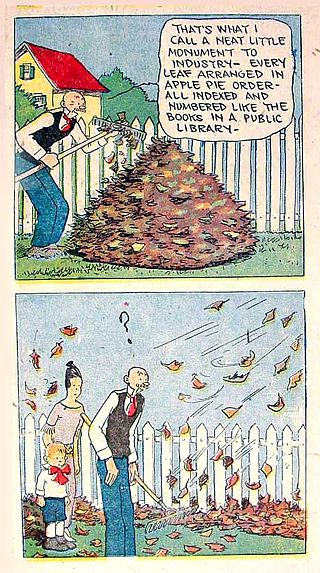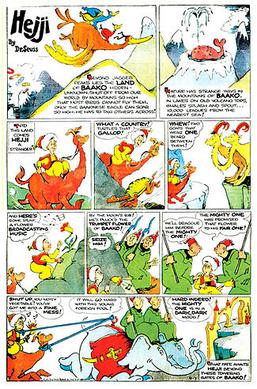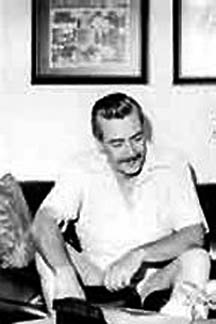
Prince Valiant in the Days of King Arthur, often simply called Prince Valiant, is an American comic strip created by Hal Foster in 1937. It is an epic adventure that has told a continuous story during its entire history, and the full stretch of that story now totals more than 4000 Sunday strips. The strip appears weekly in more than 300 American newspapers, according to its distributor, King Features Syndicate.

The Gumps is a comic strip about a middle-class family. It was created by Sidney Smith in 1917, launching a 42-year run in newspapers from February 12, 1917, until October 17, 1959.

Barney Google and Snuffy Smith, originally Take Barney Google, for Instance, is an American comic strip created by cartoonist Billy DeBeck. Since its debut on June 17, 1919, the strip has gained a large international readership, appearing in 900 newspapers in 21 countries. The initial appeal of the strip led to its adaptation to film, animation, popular song, and television. It added several terms and phrases to the English language and inspired the 1923 hit tune "Barney Google " with lyrics by Billy Rose, as well as the 1923 record "Come On, Spark Plug!"

Hejji is a short-lived 1935 comic strip, an early work and the only comic strip by prominent children's author Dr. Seuss. Hejji was produced by Geisel during the Great Depression, two years before the publication of his first book.
Don Markstein's Toonopedia is an online encyclopedia of print cartoons, comic strips and animation, initiated February 13, 2001. Donald D. Markstein, the sole writer and editor of Toonopedia, termed it "the world's first hypertext encyclopedia of toons" and stated, "The basic idea is to cover the entire spectrum of American cartoonery."

Frank Oscar King was an American cartoonist best known for his comic strip Gasoline Alley. In addition to innovations with color and page design, King introduced real-time continuity in comic strips by showing his characters aging over generations.
United Feature Syndicate, Inc. (UFS) is a large American editorial column and comic strip newspaper syndication service based in the United States and established in 1919. Originally part of E. W. Scripps Company, it was part of United Media from 1978 to 2011, and is now a division of Andrews McMeel Syndication. United Features has syndicated many notable comic strips, including Peanuts, Garfield, Li'l Abner, Dilbert, Monty, Nancy, Over the Hedge, and Marmaduke.

Tim Tyler's Luck is an adventure comic strip created by Lyman Young, elder brother of Blondie creator Chic Young. Distributed by King Features Syndicate, the strip ran from August 13, 1928, until August 24, 1996.

Chester Warren Tufts, best known as Warren Tufts, was an American comic strip and comic book artist-writer best known for his syndicated Western adventure strip Casey Ruggles, which ran from 1949 to 1954.

Lance was an American comic strip notable as the last of the full-page strips. Created and self-syndicated by artist Warren Tufts, it ran from June 5, 1955, to May 29, 1960.
Cambria Productions was the West Hollywood, California animation production studio most famous for its wide usage of the Syncro-Vox technique of animation developed by Edwin Gillette, who was a co-partner in the studio.

Robert Sidney Smith, known as Sidney Smith, was the creator of the influential comic strip The Gumps, based on an idea by Captain Joseph M. Patterson, editor and publisher of the Chicago Tribune.
Tribune Content Agency (TCA) is a syndication company owned by Tribune Publishing. TCA had previously been known as the Chicago Tribune Syndicate, the Chicago Tribune New York News Syndicate (CTNYNS), Tribune Company Syndicate, and Tribune Media Services. TCA is headquartered in Chicago, and had offices in various American cities, the United Kingdom, the Netherlands, and Hong Kong.
This is a timeline of significant events in comics in the 1910s.
Sam and Silo is an American comic strip created by Mort Walker and Jerry Dumas, which began on April 18, 1977. The series is a "continuation" or a spin-off of Sam's Strip (1961-1963), as it uses the same characters. Dumas was solely responsible for the strip from 1995 and drew it until his death in 2016.

Ferdinand Johnson, usually cited as Ferd Johnson, was an American cartoonist, best known for his 68-year stint on the Moon Mullins comic strip.

Sol Hess was a comic strip writer best known for creating the long-run strip The Nebbs with animation artist Wallace Carlson.

Colonel Heeza Liar is the star of the second animated series featuring a recurring character and the first featuring a recurring character created specifically for an animated film. Sidney Smith's Old Doc Yak appeared in 3 lost films in 1913 before Colonel Heeza Liar appeared. Smith's series though was based on his Old Doc Yak comic strip. Smith did 13 additional cartoons in 1914 and 2 in 1915. Colonel Heeza Liar was created by J. R. Bray and is mainly based on Theodore Roosevelt and the general stereotype of the 19th and early 20th century former adventurer and lion hunter. The series ran from 1913 to 1917 and restarted in 1922 until 1924. It was produced by Bray Productions and directed by Vernon Stallings. The series was animated by Walter Lantz from 1922 to 1924 and featured live-action segments interacting with the animation, much like the popular contemporary series Out of the Inkwell.
The New York World was one of the first newspapers to publish comic strips, starting around 1890, and contributed greatly to the development of the American comic strip. Notable strips that originated with the World included Richard F. Outcault's Hogan's Alley, Rudolph Dirks' The Captain and the Kids, Denys Wortman's Everyday Movies, Fritzi Ritz, Gus Mager's Hawkshaw the Detective, Victor Forsythe's Joe Jinks, and Robert Moore Brinkerhoff's Little Mary Mixup.













